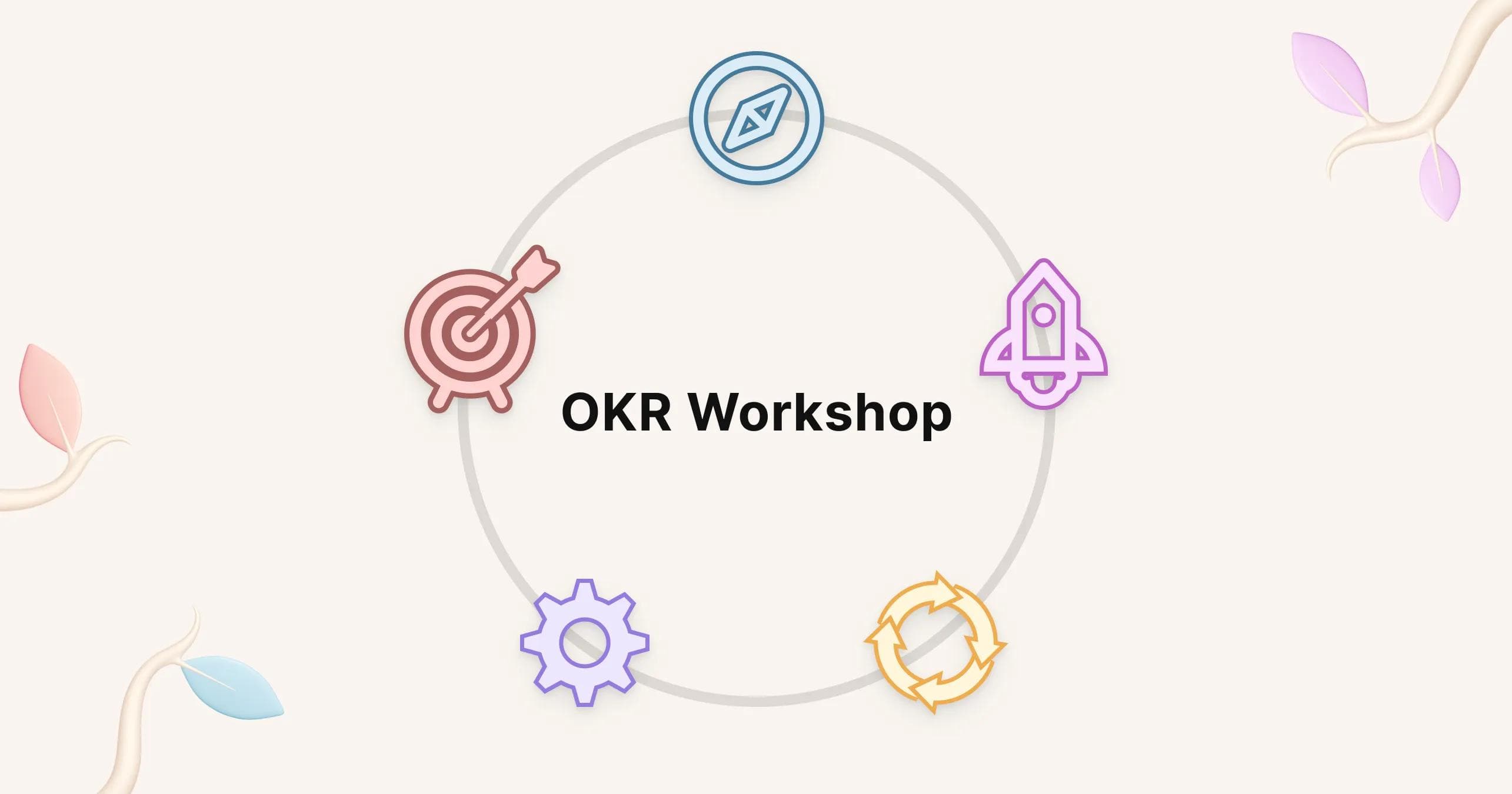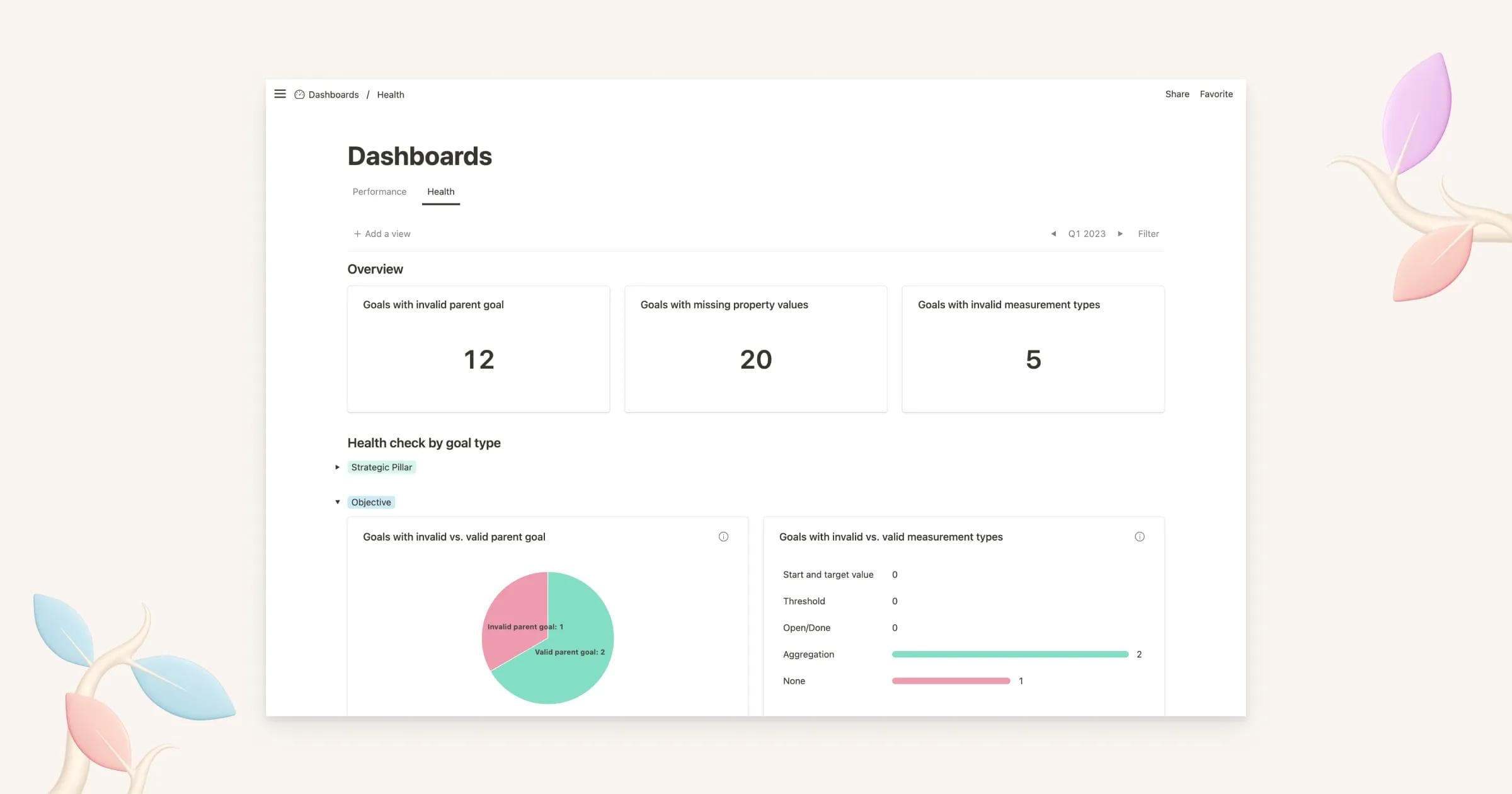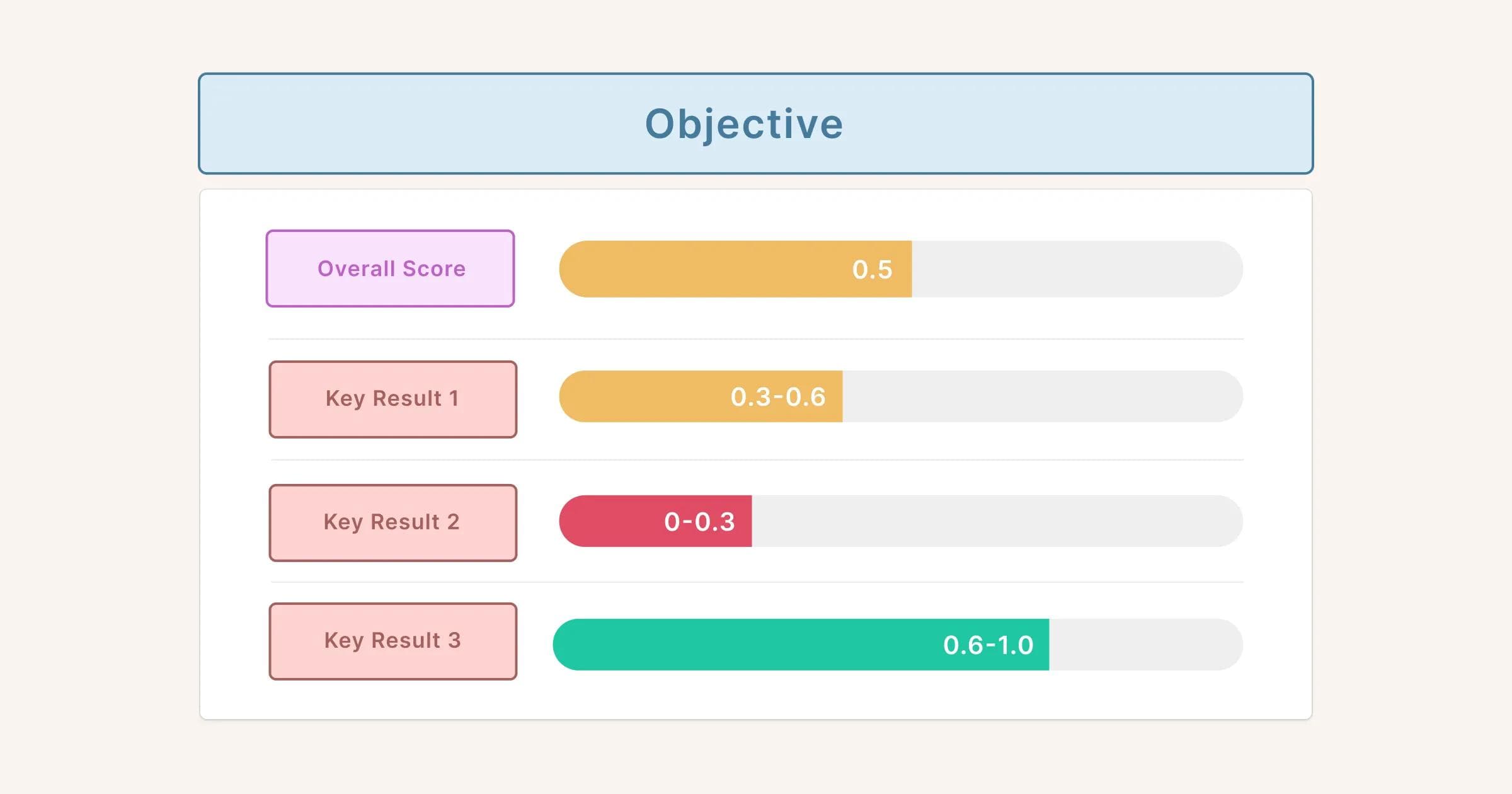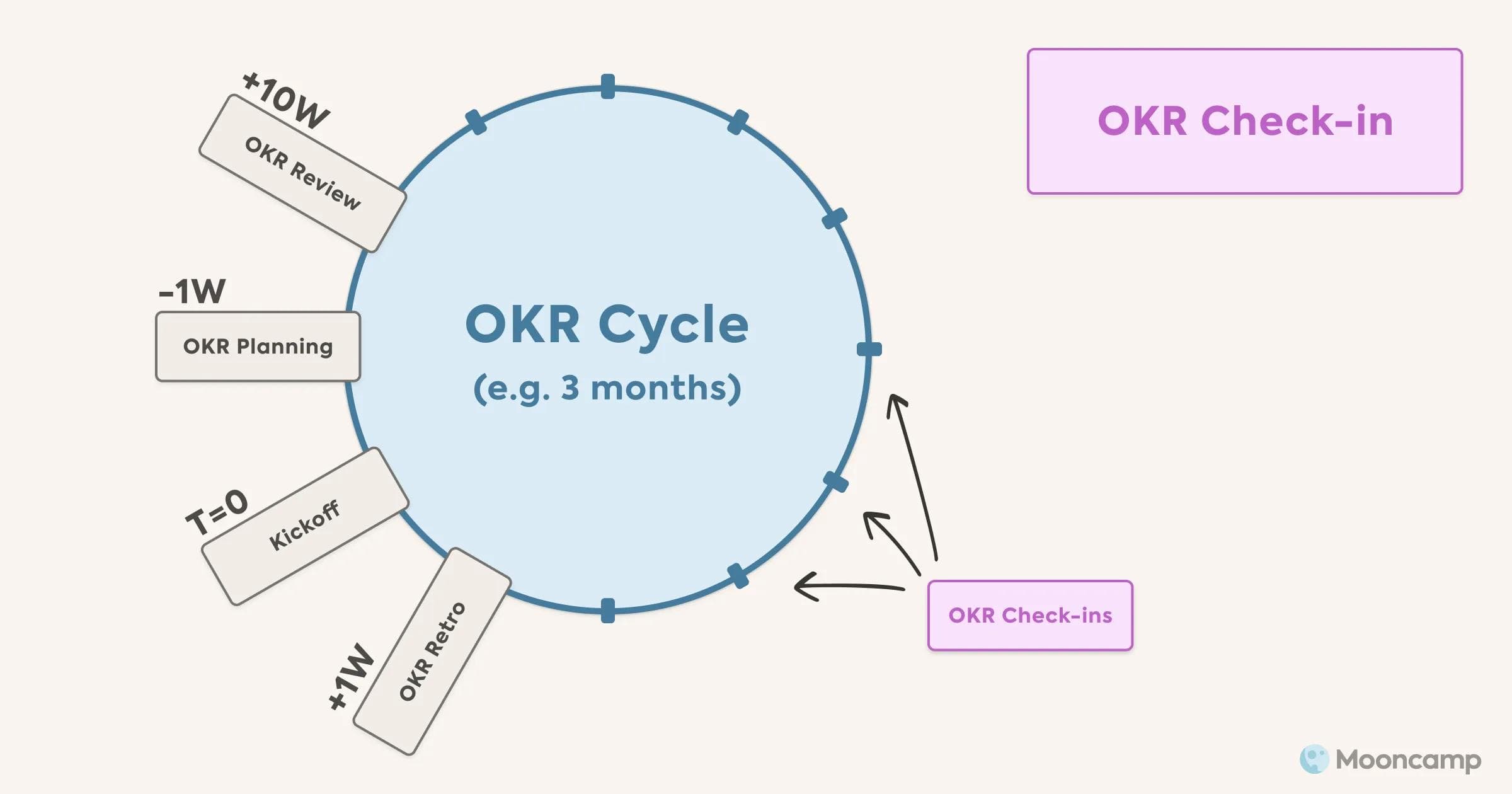One of the benefits of OKRs as a strategic framework is that they create alignments across the organization. Getting all teams and employees to work in the same direction doesn’t just magically happen. An OKR workshop helps align goals and paves the way for smooth collaboration.
- Two workshop types: Planning (create draft OKRs) and Alignment (coordinate dependencies between teams). Run planning first.
- 360-degree alignment: One lead from each functional team attends. Check resource allocation, contribution to company OKRs, and cross-team dependencies.
- Publish within 48 hours: OKRs should be finalized and shared immediately after alignment. Delays create drift.
- Transparency can replace workshops: If draft OKRs are openly shared from the start, formal alignment meetings may become unnecessary.
In this article, we explain what an OKR workshop is and why it's important. We'll also take a look at how an OKR alignment workshop is structured – including an agenda and preparation checklist.
What to expect:
- What is an OKR workshop?
- Why are OKR workshops important?
- OKR alignment workshop: preparation and process
- OKR workshop: FAQ
What is an OKR workshop?
“OKR workshops” can be defined as some of the fixed meetings and events revolving around the OKRs within an OKR cycle. They form the core of the company's OKR system and are held both company-wide and at team level. In this context, the company OKR workshops are usually scheduled before the team workshops.
💡 Reminder: OKR (short for “Objectives and Key Results”) is an agile framework for formulating and implementing strategic goals in organizations that consists of three core elements:
- Objectives: What do I want to achieve?
- Key Results: How do I know the goal has been reached?
- Initiatives: How do I achieve the goal?
As a rule, 2 to 4 Objectives are formulated per team and 2 to 4 outcome-driven Key Results per Objective. The output is mapped into initiatives (= specific tasks). More information is available in our OKR guide.
Different types of OKR workshops
An OKR cycle includes the following workshops:
- OKR planning session (aka: OKR setting)
- OKR alignment workshop
The OKR Review and OKR Retrospective can also be held in workshop format. In most cases, however, these are “normal” meetings.
💡 Note: Meetings are for discussing and debating things. Workshops, on the other hand, pursue the goal of working together to achieve a concrete result. It is important to think carefully about which format fits best when setting up the OKR cycle.
Why are OKR workshops important?
OKR workshops create commitment through fixed dates. They give structure to the OKR cycle and determine when teams should work together on OKRs. They also ensure that the OKRs are not forgotten in the day-to-day business and are regularly reflected on as well as reset.
In addition, OKR workshops serve the following functions:
- Increase engagement: The workshop gets employees involved from the start. This gives them a better understanding of how their daily tasks contribute to the company's goals and increases their commitment to OKRs implementation.
- Create focus: OKR workshops get companies and teams to prioritize and focus on what is most important in the short term.
The purpose of the OKR workshop may differ depending on where you are in the OKR cycle. The focus is always on creating something together – for example, the OKRs for the next cycle or an alignment between teams.
In focus: OKR alignment workshop
In this article, we take a closer look at the OKR alignment workshop – including an OKR workshop agenda and preparation checklist. The goal of this type of OKR workshop is to work out which other teams your own team depends on. It also identifies opportunities for collaboration.
💡 Tip: The OKR planning workshop always takes place before the OKR alignment workshop. We have summarized the best way to conduct this workshop in practice in a separate article. Criteria for good Objectives and Key Results and concrete tips on how to formulate them can also be found in our article “How to write OKRs: A guide for effective Objectives and Key Results”.
What preparations are required?
For the OKR alignment workshop to be as productive as possible, there are a few preparation steps that should be taken.
- All OKR owners should think about which other teams or OKRs they may need to achieve their OKRs. The results of these preliminary considerations will determine who attends the workshop.
- All participants should be notified well in advance about when the workshop will take place. For example, the dates for the alignment can be agreed upon and communicated during OKR planning (once the draft OKRs are available).
- The OKRs’ presentation should be prepared before the workshop and is ideally easy to understand The OKRs should be prepared for presentation in the workshop in a clear and easy-to-understand manner. All participants should be able to quickly grasp what is at stake and provide constructive feedback.
Also, determine early on where the OKR workshop will be held (e.g., in person or as a remote workshop), how much time will be needed, and who will attend.
⏱ Duration and frequency
- 2 to 6 hours (depending on the number of participants)
- After OKR planning workshop and before the start of the next OKR cycle (usually quarterly, 1 to 2 weeks in advance)
- As many workshops as needed (depending on the amount and length of discussions needed)
👥 Participants
- The OKR owners from the teams whose OKRs are interdependent
- The executive responsible for the OKRs at the enterprise level
- The OKR coach or OKR master in charge (optional)
What is the process of an OKR alignment workshop?
In terms of implementation, an OKR workshop aimed at alignment between teams or departments is usually divided into two phases: the presentation of draft OKRs from the OKR planning workshop and the publication of the OKRs. Phase one is the actual workshop, and phase two is the presentation of the results.
For example, an OKR workshop agenda might look like this:
- Introduction (10 minutes)
- Presentation of the drafts from the OKR planning (5 minutes per OKR owner)
- Discussion, feedback and questions (± 15–20 minutes per OKR owner)
- Summary of the results (10–15 minutes)
Phase two, the publication of the OKRs, can then be done either directly at the end of a successful workshop or downstream (no more than two days later). The best way to do this depends on whether the OKRs have already been visualized and prepared between OKR planning and alignment, for example in an OKR tree diagram. It is recommended to transfer the OKRs into a tracking template (e.g. our Google Sheets OKR Tracking Template) or OKR software as soon as possible.
Important: The OKRs should be formulated well enough that they are ready to be published by the end of the alignment workshop. If after one OKR session not all questions are clarified, further discussions should be held.
What is worked out in the workshop?
There are several ways to align OKRs within a company. In practice, it usually boils down to a workshop with a 360-degree alignment. One team member from each functional team takes part, usually the executive team lead.
The following points are worked out together during the team workshop discussions:
- Are there enough resources (money, people, machines)? And are those resources distributed appropriately?
- Do each team's OKRs contribute meaningfully to the company's OKRs?
- Have all dependencies on other teams been considered?
💡 Tip: If you focus on full transparency throughout the OKR process, you may even be able to skip the OKR alignment workshop. Draft OKRs are then openly shared and proactively discussed from the start.
Mooncamp can be used well for this purpose: Planning Spaces can be created directly in the software. In these closed virtual rooms, teams can record their OKR drafts before they are published. The OKRs can then be shared and receive early feedback.
However, companies new to OKRs often struggle with this level of transparency. An additional OKR workshop for alignment is therefore important in the early stages.
OKR workshop: FAQ
How to run an OKR workshop?
The structure of an OKR workshop depends on the goal of the workshop. If it is an OKR alignment workshop, the structure should be as follows: (1) introduction, (2) presentation of drafts from OKR planning, (3) discussion, feedback, and questions, (4) summary of results.
How does OKR planning work?
OKR planning is usually conducted as a workshop. The goal is to draft Objectives and Key Results at each level of the organization. An agenda for an OKR planning workshop could look like this: (1) introduction and warm-up, (2) brainstorm and formulate Objectives, (3) define Key Results, (4) visualize OKRs and add initiatives.
How do you present OKRs?
To present the OKRs, whether as a draft in the workshop or later in the final version, all the ideas should be prepared as clearly as possible. The simplest form of presentation is an OKR tree diagram. This can be created using tools such as Google Slides, Miro, or PowerPoint.





